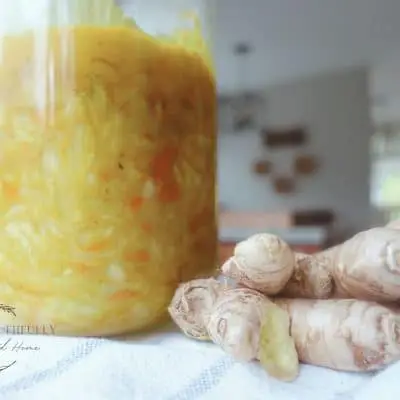
Curry Kraut
Lacto fermented curry kraut - tons of flavor and gut health benefits.
Equipment
- knife & cutting board
- quart jar with an airtight lid
- fermenting weight (or something heavy in a plastic bag to keep kraut below the brine)
- a large non-reactive bowl to combine all ingredients
- garlic press
- Cheese grater
- Canning funnel (optional but so nice)
Ingredients
- 2 lbs organic cabbage head
- 2 tbs sea salt
- 1/2 cup organic yellow onion (thinly sliced)
- 1/2 cup shredded carrot
- 6 cloves garlic (minced)
- 1 tbs fresh ginger (grated) (1 tsp ground powder alternative)
- 1/2 tbs ground corriander
- 1/2 tbs ground cumin
- 1/2 tsp ground cayenne pepper
- 1/2 tsp ground tumeric
- 1/2 tsp curry powder
- 1/4 tsp black pepper
- 1/4 tsp cinnamon
Instructions
- First, rinse your produce.
- Then, peel the outer layers off the cabbage saving a couple of the cabbage leaves for later use.
- Next, cut the cabbage in half (through the core), then in half again (so quarters), then core the cabbage. To core your cabbage, sit your wedges up vertically on your cutting board with the core touching the board and holding at the tip. Position your knife at the start of the core and slice downward cutting off that hard portion.
- After that, lie your cabbage on a flat side and slice shreds to desired thickness (I like about 1/4 inches). Start at the tip working your way down.
- Then thinly slice your onion and then shred your carrot using a cheese grater.
- Once everything is sliced and shredded place it all into a very large (sometimes 2) non-reactive bowl (not metal).
- Then, pour your spices on top of your veggies.
- Start massaging the mixture of veggies and spices with your hands. Massage until you create a lot of brine and the mixture has shrunk down to about half the size.
- After that, take your massaged veggies and spices and start packing them into your fermenting jar. The packing will help to bring the brine to the surface. After every scoop you put into the jar, pack it down with your fist. Leave several inches at the top of the jar.
- Take the cabbage leaf you saved, fold them up, and put them on top of your cabbage in the jar. Make sure the brine comes over the top of the cabbage leaf. Then place the weight (either a fermenting weight or rocks inside of a bag) on top of the cabbage leaf. Leave about 1-2 inches at the top of the jar.
- Close the jar’s lid and put the jar(s) in some sort of basin (I use a casserole dish) to catch the brine that comes out. The brine will come out of your jars because the cabbage will swell during the fermentation process and the basin will catch the brine instead of spilling onto your counters.
- Over the next few days, you’ll see the mixture start turning into the best curry kraut ever through the lacto fermentation process! You’ll see bubbles and the bright green cabbage turn into a yellow color.
- How long you wait depends on how sour you like your kraut and how warm you keep your house.
- After a few days, check the curry kraut for taste. I like to check after about 3-5 days to see if it’s sour enough for me. I also do a quick check for mold. You’ll likely see a white scummy-type substance at the top of the brine – this is ok and part of the process. You can scrape it off or leave it.
- When your curry kraut tastes how you like it, take out the cabbage leaves and the weight, close the lid, and put it in the fridge.
Video
Notes
curry kraut tips
- Don't use a reactive bowl when massaging curry kraut. A reactive bowl, like metal, can ruin the fermentation process.
- Use organic produce. Pesticides can negatively effect the ferment.
- Use high-quality sea salt. You want no additives in the salt. Table salt is virtually devoid of nutrients and sea salt has many beneficial trace minerals.
- Keep the kraut under the brine. If any bits of kraut are above the brine it may mold.
- If you need to top-off the brine with filtered water, do so.
- Leave a little place (1-2 inches) above the fermentation weights to allow the cabbage to swell.
- Keep your house around 65-73 degrees for a successful ferment.